Last updated on March 29th, 2022
Our site is reader supported, this means we may earn a small commission from Amazon and other affiliates when you buy through links on our site.
Citrus plants are not hardy British plants, however, you can still grow them successfully if you plant them in pots outdoors for summer, and bring them indoors for winter.
The most common citrus tree to grow in the UK, especially in milder parts of the country is the ‘Meyer’ Lemon but equally tolerant of cooler temperatures are Kumquats, but they all still need to be brought indoors during the winter because they are only hardy to around 10°C, this is slightly lower for Kumquats.
If you grow limes or lemons you will need to provide a bit more warmth, in a slightly warmer position, when brought indoors over winter. What we like about all of these citrus trees is that the fragrant flowers appear throughout the year and they will be particularly abundant near the end of winter. The fruit starts to ripen between 6 and 12 months later and eventually you’ll have flowers and fruit at the same time.
See our growing guide on how to grow citrus in pots by clicking here
Growing citrus trees in the UK
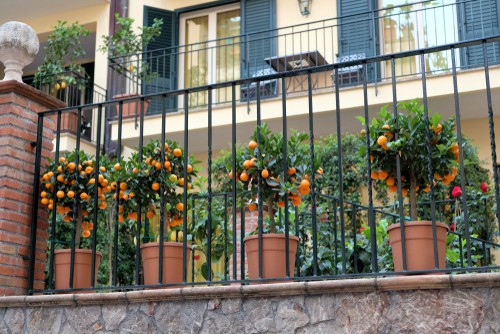
Place citrus trees outdoors in summer and bring them inside over winter
Citrus trees need to be grown indoors during the cold winter and then put back outside during the summer when the weather improves. They do quite well outdoors during the summer as long as they have a sheltered, sunny area with access to around 6 hours of direct sunlight.
Protect them with fleece in early summer in case of a late cold snap
It’s important that you keep some horticultural fleece on hand to help offset the sudden cold snaps that can manifest at the beginning of summer. As we have been known to have a late frost that can damage the flowers.
Between June and September, the temperature should be good enough but on the off chance that something unexpected happens, it’s better to be safe than sorry. Lower temperatures can inhibit flowering and when that happens not only do you not get the citrus fruits that you wanted but it can permanently damage or on rare occasions, even kill the plant entirely.
Minimum night time temperatures
Minimum temperatures at night for limes and lemons need to hover around 10°C. Oranges need minimum temperatures of around 13°C, so need to be slightly warmer. Kumquats are different in that they can tolerate winter temperatures down to 7°C so are slightly hardier.
In fact, Kumquats are some of the strongest in terms of cold tolerance out of all the citrus trees you can grow, so are sometimes better suited if you have a cooler room over winter.
Repotting citrus trees
No matter the type of citrus you choose to cultivate you should re-pot them every few years when they get too big for their container and this is something that needs to be done at the beginning of Spring. Alternatively, you can replace the top 5cm of potting soil with fresh compost on an annual basis if the pot is already quite sizable, this should also be done around March. We recommend using a specialist citrus compost or use John Innes Number 2 compost mixed with around 25% horticultural grit or coarse sand.
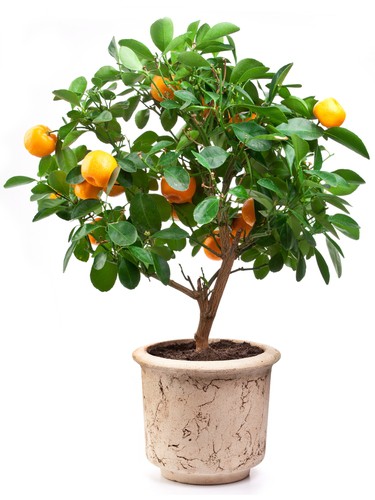
Food and Water
 Recommended citrus feed available from Amazon.co.uk
Recommended citrus feed available from Amazon.co.uk
Feeding citrus trees
When you grow citrus trees in containers they are, depending on the type, very hungry plants. You’ll need to provide a high-nitrogen citrus summer food starting at the end of March all the way through October and then make a switch to a winter citrus feed. Many lemon trees need fertiliser every month during spring and summer and then once a quarter during autumn and winter with additional feedings whenever you transplant them into a new container in March.
Watering citrus trees
They should be watered regularly throughout the summer, twice a week if they are in an indoor container and every other day if they are in an outdoor container. This should be adjusted based on the weather. As winter approaches you should allow the surface of the soil to partially dry out before you water them again. Over-watering in the winter is one of the most common problems that container-grown citrus trees experience.
Controlling humidity
If you bring your containers indoors for the winter it’s important that you maintain a high level of humidity. Citrus trees thrive best in areas that have 50% humidity, something you can measure ahead of time before deciding on the final resting spot for your indoor pots. You can place the pot on a large saucer filled with gravel and then hand mist the citrus trees regularly with a sprayer to help maintain high humidity when you move them indoors.
Pruning and Training

Citrus trees require very minimal pruning and realistically should only be pruned to control growth early on to encourage more lateral branches for the sake of training a young tree.
You can reshape your plant by cutting out any overcrowded branches in February. If your tree is particularly leggy you can prune it back, by up to two thirds, cutting back the tallest branch to encourage lateral growth. Throughout the summer you can regularly nip off the tips of the most vigorous growth to help encourage better flowering and subsequently better fruit.
Dealing with water shoots
Pay particular attention to water shoots. These are unwanted shoots that grow below the graft on your main stem. If you see any of these you should remove them immediately.
Click here to see our full guide on pruning citrus trees
Where to Put the Pots
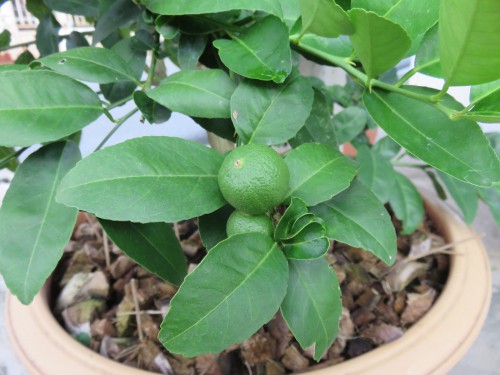
Place them where they will get at least 6 hours of sun per day
When choosing a location to put your pot outdoors remember that they need a very sunny area. Citrus plants need access to at least six hours of direct sunlight every day, whether they are placed indoors or outdoors. Most citrus trees will reach between 1m and 1.5m in height and they grow better in warmer climates with access to direct sun. During the summer they do run the risk of root burn, but only if they receive more than 12 hours of sun every day, so this is not usually a problem in most parts of the UK.
Make sure that you plant a new tree in the spring, the same time that you would transplant more mature trees and if you’re going to move them outside earlier than the middle of June, keep horticultural fleece on hand in case the temperature drops below the minimum that your particular citrus tree can handle.
Common Problems
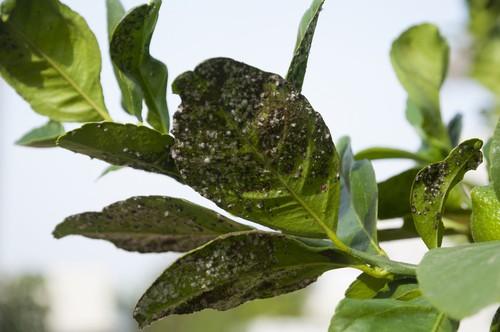
The most common problems your plant will face indoors are mildew and problems associated with too much water. Outdoors they are at risk from mealybug, scale insects, and spider mites. All of these are quite small and unless you regularly examine your plant for them, you might very well miss them until they have taken over.
Spider mites, for example, are often discovered one the leaves are mottled, pale and covered with webs. Similarly, mealybugs are often noticed once they have started sucking out sap and leaving honeydew in its place, the result of which is black, sooty mould on your leaves.
All of these problems are best dealt with in a preventative fashion, regularly maintaining the soil, air circulation, and water conditions at the appropriate levels. If you do see an infestation it’s imperative that you use commercial products to get rid of them immediately so that they don’t spread, but be sure to use a pesticide that is safe on fruit.
Harvesting citrus fruits
Citrus trees are self-pollinating so you only need one to get fruit. If you have a plant that is up to one metre tall it shouldn’t produce more than 20 individual fruits. Limes, lemons, oranges and grapefruits might need thinning here and there but Kumquats don’t have to be thinned at all.


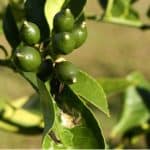
1 Comment
Thank you for helpful info on my young lemon tree.